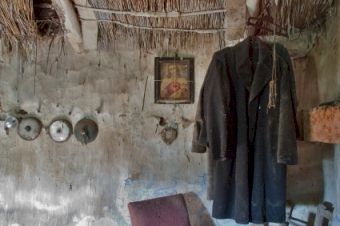- Home ›
- Irish Census ›
- 1861-1891 Censuses
What survives of the 1861–1891 Irish census returns?
Irish census returns for 1861 were intentionally destroyed by the government some time after statistical information about the population and Irish society had been collaged from the manuscripts. A decade later, the exercise was repeated.
 Interior of an abandoned cottage in County Clare
Interior of an abandoned cottage in County ClareWhile we may enjoy slinging mud at governments for their mistakes, this decision wouldn't have raised an eyebrow back then when Irish genealogy was of little interest to any other than the gentry.
Even so, these events in Ireland's census history still cause many a genealogist to weep, not least because not one of the original paper returns survive for 1861-1871, either. Not a scrap.
Surprisingly, earlier Irish censuses (for 1821 to 1851) have a marginally higher survival rate (and I do mean marginal!).
From a genealogical point of view, the only glimmer of hope from the 1861-1891 censuses of Ireland lies in JUST TWO TRANSCRIPTIONS made before the original papers were destroyed.
- 1861: The only surviving record for 1861 is a transcription for one parish – Enniscorthy in County Wexford – and even that is for Roman Catholic families only
- 1871: All that survives of the 1871 Irish census records is a transcription for the County Meath parish of Drumcondra & Loughbracken. This can be viewed free, courtesy of the Irish Genealogical Research Society
- 1881 & 1891: When it came round to the Irish census returns for 1881 and 1891, the potential value of keeping the original paperwork had, perhaps, been recognised and they were retained after they had been analysed. Sadly, a later decision to pulp them as waste paper was taken during the First World War and none of the originals survive. Neither do any transcriptions for these years. In other words, there are absolutely no surviving records available for either the 1881 or the 1891 Irish census.
Some statisical information was gathered from the 19th-century census records before they were destroyed, and I've included some ad-hoc snippets below:
| Year | Leinster | Munster | Ulster | Connacht | All Ireland |
| 1841-1851 | 15.3 | 22.5 | 15.7 | 28.8 | 19.9 |
| 1851-1861 | 12.9 | 18.5 | 4.8 | 9.6 | 11.5 |
| 1861-1871 | 8.1 | 7.9 | 4.2 | 7.3 | 6.7 |
| 1871-1881 | 4.5 | 4.5 | 4.9 | 2.9 | 4.4 |
| 1881-1891 | 7.1 | 11.9 | 7.1 | 11.8 | 9.1 |
| 1891-1901 | 3.3 | 8.3 | 2.3 | 10.1 | 5.2 |
Source: The Modernisation of Irish Society 1848-1918, by Joseph Lee.
| Year | Read and write | Read only | Neither read nor write |
| 1861 | 13.5 | 21.7 | 64.8 |
| 1871 | 19.8 | 21.5 | 58.7 |
| 1881 | 28.6 | 26.7 | 44.7 |
Source: Commissioner's Reports published at www.histpop.org
| Year | Read and write | Read only | Neither read nor write |
| 1861 | 47.9 | 23.9 | 28.2 |
| 1871 | 59.3 | 19.2 | 21.5 |
| 1881 | 73.3 | 13.9 | 12.8 |
Source: Commissioner's Reports published at www.histpop.org
Sickness and Infirmity in 1881
The 1881 census record shows there were 71,328 persons — one in 73 of the population — classified as sick or infirm on the night of 3 April. Enumerators worked to the following classification:
- 'Temporarily Sick' meant suffering some form of temporary ordinary sickness (whether or not incurable)
- 'Permanently Sick' meant those afflicted by permanent and usually incurable maladies such as deafness, dumbness, blindness, insanity and idiocy.
Although there was a classification for 'Lame and Decrepit' in this census, records show that most of these persons were healthy and useful members of their communities. They were not therefore included in the Sick and Infirm statistics.
Of the sick and infirm, 40,090 were 'temporarily diseased'. This compared with 44,052 in 1871, reflecting, according to the official report of the time, a considerable inprovement in the general sanitary condition of the people.
Some 31,238 were classified as 'permanently sick', up from 27,560 ten years previous.
The numbers suffering from Smallpox were down (from 122 in 1871) to just 39, of which two-thirds were in the province of Leinster. There were also 213 cases of Measles, 317 of Scarlet Fever, 7 of Diptheria, 197 of Whooping Cough (more than half in Ulster), 1501 of unspecified Fever, 377 of Dystentery, 2 of Cholera, and 3,500 of Rheumatism.
A further 2624 were suffering from Consumption, also known as phthisis or Tuberculosis (TB), representing a 5% increase on 1871's census record findings. Old age or Debility was blamed on the illness of 6,632 people, while 2,338 were recorded as suffering the effect of some kind of accidental injury.



